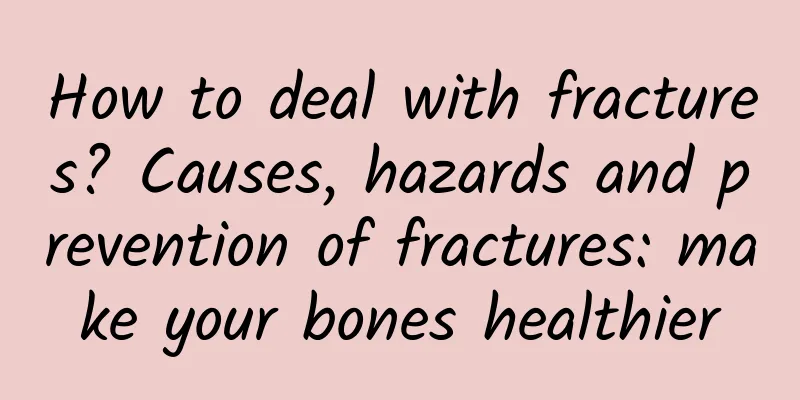How to deal with fractures? Causes, hazards and prevention of fractures: make your bones healthier

|
1. Causes of fracture A fracture is a condition in which a bone is broken or cracked by an external force. There are many reasons for a fracture, including the following. Trauma or injury: This is the most common cause of fractures, including traffic accidents, falls, sports injuries, violence or accidental impacts, etc. Osteoporosis: Osteoporosis is a disease in which bones become weak and fragile, making them more likely to break. This condition is particularly common in older people, but can also occur with certain medical conditions (such as osteoporosis), long-term use of certain medications (such as hormone drugs), and poor nutrition. Overuse or excessive exercise: Certain repetitive movements or activities, such as long-term running, heavy weight lifting, etc., cause excessive stress on bones and cause fractures. Diseases and medical conditions: Certain diseases or medical conditions can increase your risk of fractures, such as tumors, bone infections, congenital malformations, etc. Age: As we age, our bones lose density and strength, making older people more susceptible to fractures. Lifestyle habits and environmental factors: Bad lifestyle habits and environmental factors, such as unbalanced diet, lack of exercise, and unsafe working environment, can also increase the risk of fractures. 2. Hazards of fracture Pain and Discomfort: Fractures are often accompanied by severe pain and discomfort, which can affect the patient's quality of life and require long-term use of pain medication. Functional impairment: Fractures can cause loss or limitation of the function of the injured part, such as limited limb movement, inability to walk or exercise normally, etc. In severe cases, it can even lead to disability. Infection: Broken bones cause skin breaks and wounds, increasing the risk of infection, especially in the case of open fractures. Infection can delay healing or even lead to serious complications such as osteomyelitis or sepsis. Vascular and nerve damage: Some fractures may be accompanied by vascular or nerve damage, leading to serious consequences such as bleeding, loss of sensation, and limb paralysis. Deformity and dysfunction: If the fracture does not heal well or is improperly treated, it can lead to deformity of the injured area, affect the appearance, and cause long-term problems such as joint stiffness and dysfunction. Psychological impact: Fractures not only affect the body, but also bring psychological burden and anxiety to patients, especially during long-term rehabilitation and functional recovery, which may cause frustration and loss. 3. Prevention of fractures Get enough calcium and vitamin D: Calcium and vitamin D are essential nutrients for maintaining bone health. Foods rich in calcium include dairy products, fish, beans, green leafy vegetables, etc. In addition, vitamin D helps promote the absorption and utilization of calcium, and the level of vitamin D in the body can be increased through sunlight exposure or vitamin D supplementation. Get proper physical exercise: Aerobic exercise, strength training, and balance exercises are all important for strengthening bone health and reducing the risk of falls. Proper physical exercise can increase bone density, strengthen muscles, and improve balance, thereby reducing the risk of fractures. Avoid dangerous behaviors and environments: Avoid high-risk activities and environments, such as rock climbing and extreme sports, to reduce the occurrence of accidental injuries. Set up anti-slip facilities at home and in the workplace to reduce the risk of falls. Quit smoking and limit alcohol consumption: Smoking and excessive drinking can have adverse effects on bone health and increase the risk of fractures. Quitting smoking and limiting alcohol consumption can help maintain bone health. Pay attention to a balanced diet: Maintaining a balanced diet with adequate protein, vitamins and minerals helps maintain bone health. Regular bone density examinations: Especially for middle-aged and elderly people and those at risk of osteoporosis, regular bone density examinations can help detect osteoporosis early and take timely prevention and treatment measures. Use assistive devices: For some people who are at risk of falling, such as the elderly or those with a history of sports injuries, consider using assistive devices such as crutches, escalators, etc. to help them walk more safely. 4. How to deal with fractures? Make your bones healthier First aid measures: If you suspect a fracture, stop the activity immediately to avoid further injury. Use a clean bandage or cloth to fix the injured part to relieve pain and fix the bone. If there is bleeding at the injured part, stop the bleeding first. Transfer the injured person to the hospital emergency room or receive professional medical treatment as soon as possible. Professional treatment: The doctor will take an X-ray to confirm the type and severity of the fracture. Depending on the type and location of the fracture, the fracture will be reduced or treated surgically. After reduction or surgical treatment, the doctor will apply appropriate fixation devices, such as plaster, splints, or external fixators to stabilize the fracture site and promote healing. Rehabilitation and recovery: Patients need to follow the doctor's instructions to perform appropriate rehabilitation exercises to restore the function and strength of the injured part. Rehabilitation exercises include passive and active joint movements, gradually increasing the amount of exercise, and physical therapy. The rehabilitation process requires patience and persistence, and patients should actively cooperate with the medical team for treatment and rehabilitation plans. Author: Wang Cheng, Yanting County Traditional Chinese Medicine Hospital |
<<: Will milk tea be classified into nutritional levels? Which level of milk tea is healthy?
Recommend
APP operation: How to design an activity that users can’t stop
520 has just passed and the Dragon Boat Festival ...
Is Chen Yizhou a loser?
"Just get half an economy class ticket first...
Will Jupiter's hydrogen burn up and eventually become a small sun?
This topic has been discussed many times. Since f...
List of "Science" Rumors in March 2023: Can you take oseltamivir on your own after being infected with influenza A? Are wild vegetables green foods?
The list of "scientific" rumors for Mar...
Surface Pro 3 review: Not a tablet, but a convertible ultrabook
Microsoft's third-generation tablet computer, ...
For a product with 100,000 users, how should user activation be carried out?
For user operations personnel, if the product has...
Rivian Financial Report: Revenue in Q1 and Q4 of 2021 Fiscal Year was US$54 million, and net loss widened year-on-year
Electric vehicle startup Rivian released its firs...
The glory of "Chinese products" in the Song and Yuan Dynasties! Its exquisite craftsmanship impressed the world and sold well in many overseas countries
The lotus-petal-patterned bowl from the Song Dyna...
Three members of the Chinese fencing team were diagnosed with COVID-19, and the entire team was isolated for medical observation!
China News Service, March 20. On the 20th, the Ch...
Guiyang High-end Sauna Bath Leisure Club_You will never forget the tea tasting here
Guiyang High-end Sauna Bathing Leisure Club_You w...
No matter how much you calculate, don’t miss this trillion-dollar opportunity!
Mixed Knowledge Specially designed to cure confus...
The key points of epidemic food reserve: the most complete and condensed version ever
Recently, the epidemic situation in many places i...
Did a main-belt comet collide with the source of life?
Where does the water on Earth come from? Recently...
Growth Hacker: Amap’s Path to User Growth!
On October 1, Liu Zhenfei, Alibaba partner and pr...









